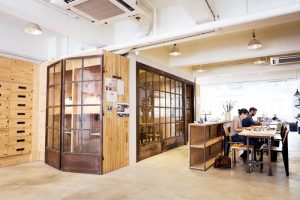The pandemic has made it difficult for flex space operators to run a profitable business
Offices around the world were left empty during the pandemic, making business particularly tough for some flexible-space operators as occupiers reacted to economic upheaval.
Now, some of the larger flex space operators are looking to capitalize on challenges in the sector, pushing ahead with plans to expand.
Table of Contents
In June, listed flex-space operators, IWG, took over 30,000 square feet of office space in Hong Kong that had been leased previously by another flex operator. U.S. groups Serendipity Labs and Industrious are also in a strong position to expand, says Ben Munn, managing director, flexible space at JLL.
The interest isn’t likely to dissipate given corporate demands for holistic workspace solutions, with pressure on legacy business models driving consolidation, Munn says.
“The operators which came into this challenging period in a strong financial position with well-established businesses, limited vacancy and favourable underlying real estate deals are able to look at two main routes to expansion: either taking over space from another operator and or acquiring the businesses of struggling competitors,” he says.
Both happen, but particularly the former. “In some cases, the previous operator has exited their lease, or in others collapsed the special purpose entity holding the lease, leaving the landlord with no recourse,” Munn says. “Or it may simply be that an operator presented unfavourable terms to the landlord for renegotiation and the landlord is taking the opportunity to restructure the workspace proposition in the building.”
A changing landscape for flex space operators
There are other opportunities for smaller flex space operators as well, with new operators expected to enter the market.
“For example, hotel operators will look at the flex office space market as well as new entrants from within the real estate market. The flex space industry is still in the early stages of its evolution so the landscape will look a lot different in five years’ time,” says Munn.
The coronavirus pandemic is putting economic pressure on tenants but also making it hard for them to forecast their property needs, which is driving a preference for flexible space. Munn says: “Demand forecasting was already a very inexact science for occupiers before COVID demonstrated how external events can completely change space needs. We are now in a situation where cash is king, conservation of capital is key, and occupiers want to make sure they manage their real estate liabilities downwards.
“Flexibility and agility will be increasingly important going forward and the supply side of the market will have to respond to this as we are going to enter a period of oversupply. Landlords that respond to the customer’s needs for flexibility, cost certainty, and all-inclusive workplace product and service propositions will win out.”
Corporate real estate executives will have to navigate a more complex world, applying workspace solutions along a wider spectrum of choice, from on-demand space to more traditional long-leased or owned assets.
The businesses and employees they support will have increased demands for flexibility. Although freelancers are more likely to shed coworking space as the COVID-19 outbreak stalls business, 67 percent of corporate real estate decision-makers are increasing workplace mobility programs and are incorporating flex space as a central element of their agile work strategies, according to JLL.
This will present challenges to landlords. The growing proportion of flex space – JLL expects 30 percent of all office space globally to be flexible in some form by 2030 – means fewer long leases. Valuing flex space is more complicated, and security of covenant will be crucial.
“There will have to be fresh thinking in real estate capital markets and the provision of transparent data so buildings with a range of space offers can be valued more accurately,” says Munn.
“You need valuation methodologies which account for variable performance. The traditional, long-leased office is a very simple asset by comparison and with long-accepted valuation methodologies, but also one where there is little room for management to generate outperformance. That will have to change going forward.”
An earlier report by Colliers International said that flex space operators in Singapore are expected to play a key role in the return to work for many enterprises in Singapore and the scale of the sector presents an opportunity for operators to offer a range of products to assist occupiers in executing their occupancy strategies. New take-up from flex space operators will mostly pause over 2020, with any new take-up being driven by partnerships or management agreements with asset owners.

Colliers International’s Flexible Workspace Outlook Report 2020 provided an overview of the overarching trends that are shaping the sector, implications for operators, occupiers and asset owners, as well as forecasts the pivotal role of flexible workspace for the industry in 2020.
Jonathan Wright, Director, Flexible Workspace Consulting, Asia, at Colliers commented: “Events in late 2019 and H12020 have accelerated previously forecasted trends in the flexible workspace sector, including enterprise outsourcing becoming mainstream; highly amenitised assets with best-in-class hospitality being ‘table stakes’ for any new office development; a continued boom in wellness offerings; a revival of suburban locations; and further operator fragmentation, while new trends have also emerged, such as the integration of home as a place of work and the growing importance of the digital experience.”
Sam Harvey-Jones, Managing Director, Occupier Services, Asia, added: “As markets start to recover from the effects of COVID-19, we expect to see an increase in demand for flexible workspace models, particularly because there will be a greater emphasis on health and wellbeing, hygiene, and work-life balance in the workplace going forward. Businesses will likely adopt smaller office ‘hubs’ in decentralised locations, allowing them to save on space / costs while also benefiting their employees who will have shorter commute times.”





